The Shark Detective
Greg Skomal has been tailing great white sharks for more than a decade to unravel the many mysteries they raise—including how to deal with their growing numbers off Cape Cod.
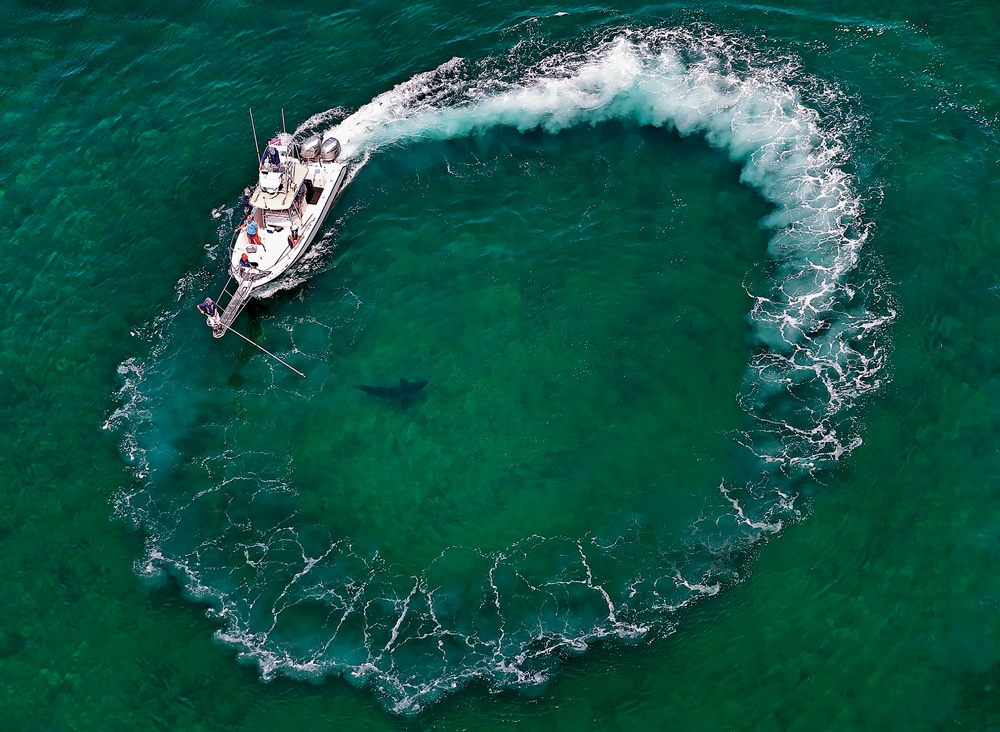
As his team’s boat circles a shark off Longnook Beach in Truro, Massachusetts, marine biologist Greg Skomal prepares to tag the animal with a tracking device in this 2018 file photo.
Photo Credit : David L. Ryan/The Boston Globe via Getty Images
Photo Credit : David L. Ryan/The Boston Globe via Getty Images
On a cloudless Tuesday in mid-October, Greg Skomal, one of the world’s foremost experts on white sharks, hung over the bow of his research boat as it idled just offshore from Chatham, Massachusetts, and stared down at the water, seemingly trying to will it to cooperate. Thanks to several rounds of rain and wind, it had been two weeks since he’d last been on the water. All that rough weather had churned up the shallows so that now, even on a clear day, visibility was only a few feet.
“This is challenging,” he said to no one and everyone, a group that included the boat’s owner and pilot, John King, a retired biotech executive who’s worked with Skomal since 2014, and Megan Winton, a staff scientist at the Atlantic White Shark Conservancy. Circling in the sky above them was spotter pilot Wayne Davis.
Skomal turned from the water. “This isn’t normal,” he said.
For the 58-year-old Skomal, a senior biologist with the Massachusetts Division of Marine Fisheries, a normal day means unrelenting action. Davis might radio in as many as 25 white shark sightings as the research boat runs up and down the Outer Cape for seven hours at a stretch. During much of that time, Skomal mans the bow pulpit, trying to catch video of a shark or stick a tracking tag on it. His first chance to eat often comes at the end of the day, when King starts motoring back to the harbor.
Over the past few years there have been many such days for Skomal, who predicted the return of white sharks to New England and pioneered much of the early research on their presence. In 2009, he was the first to tag a white in the North Atlantic, and as that population has surged—making the Cape a global hot spot for white shark activity—Skomal’s body of work has grown too. So has his profile: He’s appeared in numerous shark-related films and documentaries, including for National Geographic, the Discovery Channel, and ESPN. Last summer he led a 60 Minutes team on a tagging expedition for a segment to launch the program’s season opener.
Widespread fascination with white sharks drives some of this attention. But a pair of high-profile attacks off Cape Cod in 2018, including the first shark-related fatality in Massachusetts waters in 82 years, have also cast the subject in a different, more dangerous light. Last summer, Cape lifeguards temporarily closed beaches or suspended swimming 63 times due to shark sightings near shore; at just a few outer beaches alone, more than 50 sightings were reported. At a moment when the legacy of public beaches on the Cape is clashing with a new reality on access to those waters, Skomal’s work may be the most important asset that local and state officials have in trying to both protect the Cape’s billion-dollar tourist economy and maintain its conservationist heritage.
Last year Skomal and Winton, his counterpart at the Atlantic White Shark Conservancy, put public safety at the center of their work. Skomal met with Outer Cape lifeguards at the start of summer to devise a plan to keep swimmers on sandbars in water no deeper than their waist. More significant, his department at the Division of Marine Fisheries launched a five-year study on shark behavior, moving Skomal away from traditional population work—the who and where—and toward a better understanding of the conditions that precipitate a shark attack.
“We need to drill deeper,” he told me in an interview early last fall. “I’ve been thinking too much about what these sharks do every month or every year, but I need to think about what they do every minute, every second—what’s happening right now, and five minutes from now. If we can predict patterns, then we can forecast. And if we can do that, we can advise the public that a certain area at a certain time of day is a high-risk zone.”
But studying fish means seeing fish. And back on the research boat, after a good hour on the water with no luck, King turned to ritual as a way of changing the trip’s fortunes. Out came a bag of pretzel rods. What had started years before as a way to help visitors adjust to the sea was now seen as a good-luck charm. “Everyone has to have one,” King said, passing the bag around. Skomal, who has a full head of gray hair that hangs over his ears and a toothy smile that signals his unsuppressed sense of humor, plucked a rod and stuck it in his mouth, clenching it between his teeth like a cigar. “Come on, Wayne,” he said in a playful growl. “Stop fooling around and find us a fish.”
And then, he did. About 30 minutes after the pretzels appeared, Davis radioed in a sighting half a mile north. King wheeled the boat around. “Hold tight,” he yelled, gunning the engine. The boat rocked and water sprayed over its sides as it crashed through the waves, but Skomal moved with an easy steadiness, grabbing his GoPro camera, which was attached to the end of a fiberglass pole, and heading to the pulpit. When King got within the shark’s vicinity, Skomal jammed the camera into the water and directed him to the target as if helping him back up a trailer. A little to the right. OK, now to your left.
Through a haze of blue and aqua green, the shark finally came into focus—sort of. The animal looked less like a fish and more like a shapeless dark mass as it slowly but purposefully moved through the water. With Skomal running his camera, the shark cruised by the boat’s port side before passing beneath the vessel and slipping away into deeper waters.
As the day wore on, Skomal and Winton used the slack time to check some of the 45 acoustic receivers that they’ve stationed off the Cape, each topped by a long yellow buoy. These devices log the presence of a tagged shark whenever it passes within a few hundred feet of them. After heaving one onto the boat, Skomal inserted a magnet into the receiver to activate it and send packets of info winging over to Winton’s tablet via Bluetooth.
“You know who was here the other day?” Winton said at one point, scanning the data. “Jamison!”
Skomal would never say he develops a relationship with the sharks he studies, but there is an inevitable familiarity. He chronicles their growth, documents new scars, and knows intimately which areas of the North Atlantic they frequent. In 2015 he led an effort to save a juvenile shark that had been beached in Chatham. As locals threw water on it, Skomal took blood samples and tagged the fish, which he named Jamison, before helping haul it back out to sea.
“Jamison!” Skomal exclaimed, sounding as though an old friend had just reappeared.
Winton stared at her screen and smiled. “Oh, that little peanut.”
By early afternoon, King had moved the boat south, to just off Monomoy Island. On shore, several hundred seals—whose expanding population is closely linked to the presence of white sharks near the Cape—clung to the beach. Talk of calling it a day had already started when Davis called in a sighting a little farther south.
As King maneuvered near the shark, Skomal, who was again perched on the pulpit, became exuberant. “Big fish!” he shouted. “He’s long! I think he’s got length.” He circled the camera around in the water. “Boy, that’s a nice dorsal.”
Skomal was standing right over the shark, which recalled an incident from the summer in which a shark had burst out of the water and snapped its jaws just inches beneath his feet. In a video of the moment, Skomal can be seen nervously hopping up and down, which he later jokingly called his “shark two-step.” On this day, Skomal playfully reprised the move. “This is where I get nervous,” he said, grinning.
But soon, like the one before it, the fish slipped under the boat and disappeared. Skomal scanned the sea: It was gone.
“He’s got a cloaking device!” he exclaimed. “What’s next? Wings?”
Skomal took a seat and leaned back. “We can’t see a thing,” he said, clearly frustrated. “But there are sharks there. We know they’re out there.”
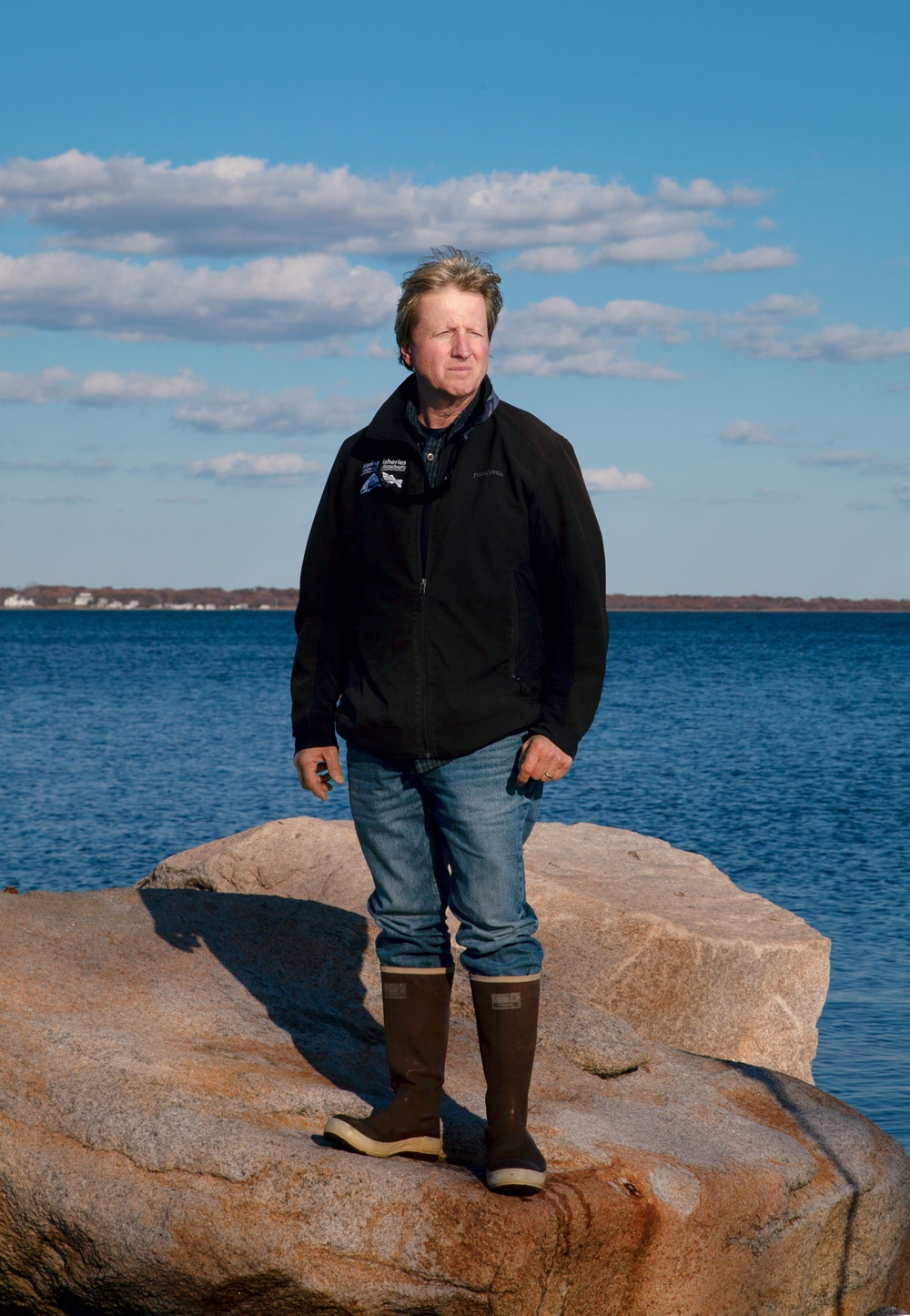
Photo Credit : Dana Smith
Skomal’s obsession with ocean life started early and never relented. The fourth of seven kids, he was raised in Fairfield, Connecticut, in a home that prized individuality. At the age of 20, his father, Bernie, who loved photography, had bolted from the confines of a midwestern life in Omaha, Nebraska, to pursue big dreams in New York City. Even after he married Skomal’s mother, Irene, and the demands of their expanding family made him pivot toward owning an insurance agency, Bernie never let go of his camera or the idea that it was important to stay close to what you loved most in life. For his second-oldest son, that meant the sea.
“I just thought fish were really cool creatures,” Skomal told me from his office in New Bedford. The third-floor space is located in a building the state shares with the University of Massachusetts, where he serves as an adjunct professor. “We’re terrestrial animals, and when we look at the ocean all we see is the surface. But what is actually down there is a whole other world that’s not only mysterious but also generates fear. And I was drawn to that.”
Skomal was a child of the early ’70s, which saw an explosion in underwater photography and the rise of the scuba diving scene. He feasted on Jacques Cousteau films (for a time, he even wore a red knit cap like his hero) and built aquariums with his buddies. On family Christmas trips to St. Croix, where the Skomals owned a condo just steps from the water, young Greg got to see for himself some of the marine life he had watched on TV. He taught himself to snorkel and skin dive, and later he earned his scuba certification.
But it was a Hollywood blockbuster that changed everything for Skomal. In July 1975, Jaws smashed onto the summer scene and into the country’s imagination. Skomal, then 14, was gripped not just by the story of a monster shark terrorizing a tourist town but also by the nerdy but adventurous scientist, Matt Hooper, played by Richard Dreyfuss. A new world opened up to Skomal, as he realized the opportunity to make a life studying the ocean extended far beyond a select few Cousteau types.
In the fall of 1979 Skomal enrolled at the University of Rhode Island, where he majored in zoology and biology. While his studies didn’t exactly get him out on the water, the Narragansett National Marine Fisheries Laboratory, which made its home at URI, did. Under longtime director Jack Casey, the lab had pioneered much of the early shark research. Its staffers tagged fish, collected samples at different fishing tournaments on the East Coast, and picked the brains of fishermen about what they were seeing and dealing with. Skomal landed a job with the lab the summer before his senior year and immersed himself in all of it.
“It was a lot of blood—‘nuts-and-guts work,’ as we liked to call it,” he said. “Being there was like a dream. You’d walk into the office and there were books about sharks, shark jaws, shark artwork, and they were doing real research and publishing their papers. And I got to work with really cool mentors, guys who were giants in the field.”
Following a five-year stint with the Narragansett lab, Skomal took a job in 1987 with the state of Massachusetts, which had just used a round of federal funding to create four new positions in its fisheries division: two on the Cape, one in Boston, and one on Martha’s Vineyard. Skomal elected to take the location nobody else wanted—the Vineyard—and that summer the 26-year-old scientist moved into a makeshift office in a former lobster hatchery in Oak Bluffs, where he was charged with developing the state’s nascent shark program.
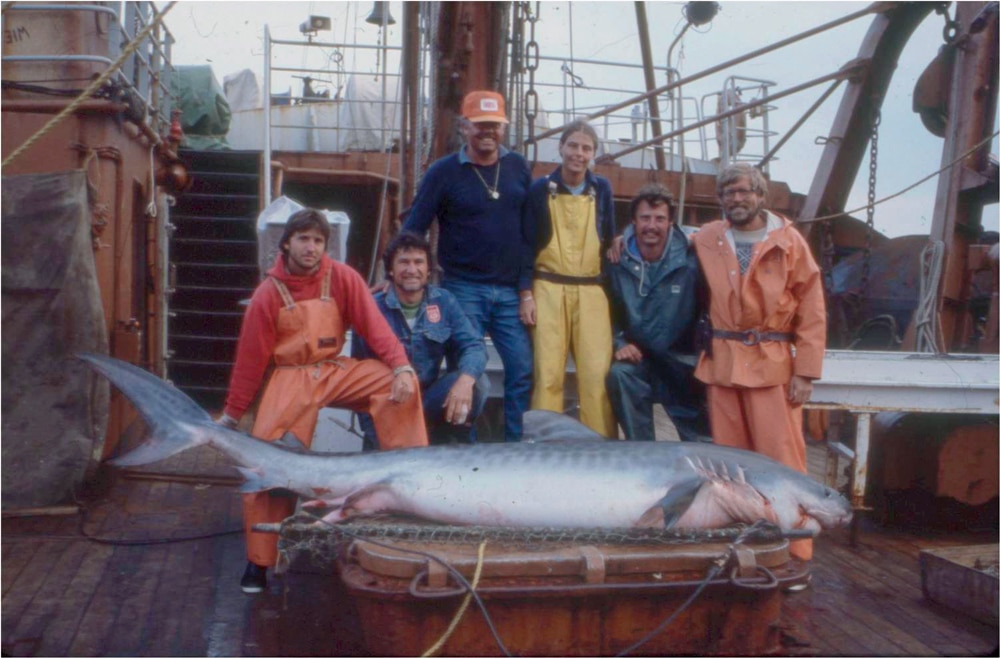
Photo Credit : Courtesy of Greg Skomal
For Skomal, it was a dream scenario. He was young and single and living on the very island where Jaws was filmed, and he had a huge appetite for the work. “He was inexhaustible. He had that natural interest that was just there all the time,” Brad Chase told me. After working with Skomal at the Narragansett lab, Chase had moved with him to Massachusetts, where he is now a senior biologist. “We were kids and viewed as these cowboys who didn’t really fit in. We had come to a state facility where there was this older generation of guys who’d gotten their jobs because they hunted or fished with somebody who worked here. It doesn’t mean there weren’t some great scientists here then, but there was this general culture of taking it easy, and so Greg was constantly being told to slow down. That’s not his style.”
Working in waters off the Cape put Skomal in the perfect place at the perfect time. The appearance of white sharks in the North Atlantic in the 2000s was precipitated by two important government actions. The first was the 1972 Marine Mammal Protection Act, which made it illegal to kill gray seals, an animal that had been hunted to near-extinction. As a result of this protection, today some 50,000 gray seals live on the Cape, and an estimated half million are scattered between Maine and Massachusetts. The second key move came in 1997, when the U.S. enforced a ban on hunting white sharks following a report that their stocks had plummeted by three-quarters since the early 1960s.
By the mid-2000s, as the gray seal population in Massachusetts began to significantly rebound in places like Monomoy and Muskeget islands, Skomal started receiving what he believed were credible reports of white shark sightings from fishermen. He began pushing the idea not only that a small number of Atlantic whites had made it as far north as New England, but also that these deepwater fish may have a reason to come close to shore—namely, lots of food.
A ratcheting-up of reports from around Massachusetts pointed the way. There was the sighting by a couple of Chatham beachgoers of a shark cutting a seal in half with a single bite in 2006; two gutted seals on a beach in Chatham in 2007; and a small white shark that washed up dead on Nantucket in 2008. Most dramatic, a 14-foot female white shark had been trapped in a saltwater pond and caught live on Naushon Island, off Woods Hole, in 2004. Yet even with this mounting evidence, Skomal remained a lone voice.
“I’d go to these seal meetings and I’d put forth a model that showed that … we will likely see white sharks feeding on seals in greater numbers,” Skomal said. “Marine mammal people are very passionate about their work, and I was probably seen as the guy who studies the animals that eat their animals. I never got much feedback. I was typically drinking my beer alone afterward. But I remember going to [a meeting] as late as 2009—and wouldn’t you know it? Within a month we started tagging our first white sharks.”
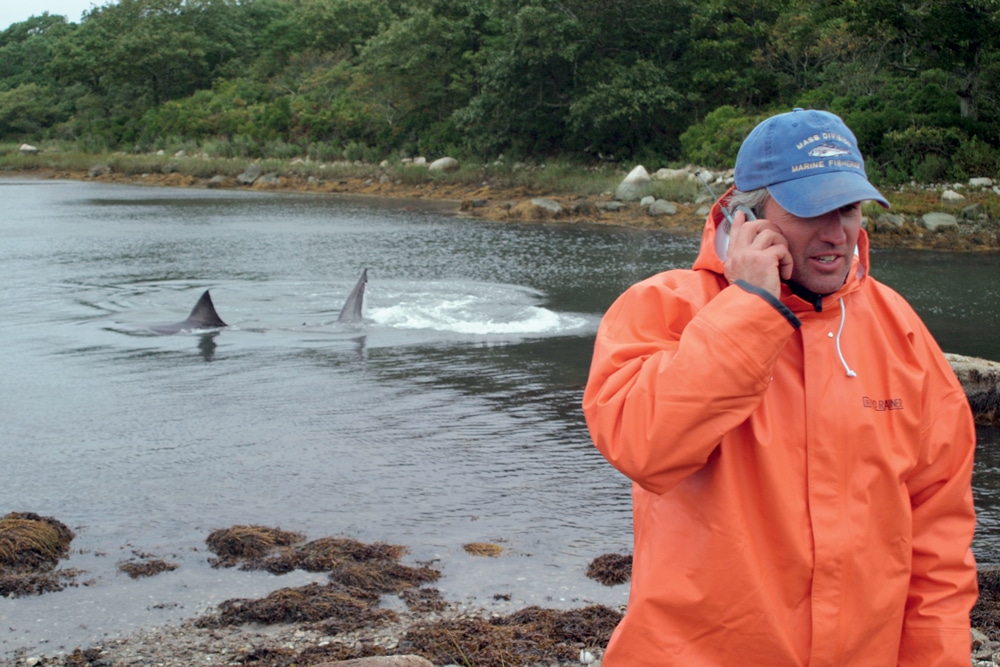
Photo Credit : Ed Lyman/DMF
One evening in late September last year,Skomal sat in a back room of the Cape Cod Museum of Natural History in Brewster, sifting through his mental notes for a talk he was about to give to a crowd of 100 or so. As the attendees nibbled cheeses, sipped wine, and had their photos taken in a shark cage that the museum had set up in a main hall, Skomal tried to catch his breath. Since 2010, he has lived on the mainland and worked out of the New Bedford office, but it wasn’t just a full day of meetings and paperwork and the mad dash to Brewster that had worn him down. The summer had been especially busy, and over the past few weeks in particular, the weather had cooperated. There had been a lot of time on the water, including a long stretch of filming with the Discovery Channel team.
“I’m at that point of the season where I’m starting to reach the saturation point,” he confessed. “Media burnout, fieldwork burnout, shark work burnout. It’s just nonstop.”
There had been some breaks, though—the most important of which was when Skomal and his wife, Kimberly, and their kids, Will, 12, and Eve, 9, left their home on the South Shore to visit family in Killington, Vermont, over Labor Day weekend. “[It’s] a chance for me to just get away from the salt water,” he said, and laughed. “We hike in the woods, we go in freshwater lakes, we kayak. We get to smell fresh dirt. I come back feeling refreshed.”
A few minutes later, Skomal—wearing khakis and a blue short-sleeve button-down that he left untucked—took the stage looking and sounding as though he’d just emerged from those Vermont woods. He flashed a big grin and moved with an energetic step. “Who has seen me speak here before?” he asked. About the half the room raised their hands. He laughed. “Well, you can go home now.”
Over the next hour, Skomal walked the audience through his early career, his memories of the very first whites he’d tagged, and his current work. Skomal spoke without notes, his ease born of years spent doing these kinds of events; he was lively and fun. After showing some especially close underwater footage of a shark, he said, “We’re really happy to have GoPros now—we used to have to use graduate students to get this kind of video.”
Afterward, a good third of the crowd lined up to shake Skomal’s hand, have him sign a copy of his 2008 book, The Shark Handbook, and grab a selfie. One of them, a man in his 40s in a Red Sox ball cap, had driven all the way from Burlington, Vermont, to attend the talk; he planned to turn right around and head home. “I really wanted to see this,” he said to an amazed Skomal.
All this speaks to just how far Skomal’s work has come over the past decade and a half. Even after tagging those first whites in September 2009, he didn’t have an established budget to keep the work going. So he improvised, snagging dollars from other projects to fund his research while applying for grants and making appeals to donors. Money was needed for the boat time, the airplane spotter, and the satellite tags, which run $4,000 a pop.
Everything changed in 2013 with the founding of the Atlantic White Shark Conservancy. Launched to help support the state’s research program and to increase public safety outreach, the nonprofit got off the ground thanks to three Massachusetts residents: John King, the retired biotech entrepreneur; Cynthia Wigren, a former vice president for a large energy trader; and Cynthia’s husband, Ben, a finance executive. The three shared an obsession with white sharks and weren’t averse to flying halfway across the world to photograph and dive with them.
Since being established, the Atlantic White Shark Conservancy has opened the doors to an education center in North Chatham, started a summer program for kids, launched a podcast, and rolled out a mobile app that alerts users to shark sightings in Massachusetts. And all in all, it’s contributed more than a million dollars toward Skomal’s research.
“He’s credible, articulate, and available,” says King. “And he’s very comfortable at communicating at all different levels. In the science world, so much of it these days is guys hoarding their information because knowledge is power and what only they know is key for their getting the next grant. He isn’t like that at all. He shares everything. He just wants to learn, and that makes it so you want to help him.”
On the morning of September 15, 2018, Skomal was leading one of the conservancy’s shark viewing tours out of Plymouth when his phone started to blow up with news alerts and text messages about a shark attack off Newcomb Hollow Beach in Wellfleet. What Skomal and the rest of the world soon learned is that Arthur Medici, a 26-year-old Revere native and part-time engineering student, had been boogie boarding with a friend about 40 yards offshore when a white shark bit both of his legs. Medici died at Cape Cod Hospital later that day.
As the news continued to pour in, Skomal’s heart sank. Continuing to lead the tour, he found himself bouncing between worlds: keeping up his role as guide but also wrestling with questions from attendees who were learning about the attack. He also had to think about what might come next. In the past couple of years there had been a few nonfatal shark encounters in Massachusetts, including one in Truro a month earlier, but this was the state’s first shark-related fatality since 1936.
“I knew immediately a switch had been flipped,” Skomal told me. “The game had changed to some extent. I knew there would be a public outcry, the call for some mediation, for white shark measures to be put in place.”
Over the next month he was deluged with press interviews. National and local media, London tabloids, and network television all came calling. Headlines like “Right Out of Jaws” fueled the mania, as did a demand for answers that no scientist could provide. Why did the shark attack? Would it attack again? Can sharks develop a taste for human flesh?
“These are tough questions,” Skomal told me. “And deep down, you know it. One of these sharks killed a person.”
He paused. “It killed a person. That’s pretty profound.”
He paused again, then added, “I would be lying if I said I didn’t fear them to some extent.”
The fatal attack also put a spotlight on the public’s changing relationship with white sharks. After the 1997 hunting ban took hold and the sharks’ numbers rebounded, their occasional appearances in Cape waters were viewed with something like reverence. When that white shark got trapped in a pond on Naushon Island in 2004, Skomal found himself a target of Cape Cod residents who were concerned about her safety. “I was getting threats if I didn’t save the shark,” he said.
But later, as warning signs, 911 call boxes, and trauma kits were installed at beaches along the Outer Cape, that reverence began to compete with a different sentiment, the feeling that the Cape should revert back to an era when swimmers and surfers didn’t have to think about sharks. In the past two years especially, there’s been increased talk of culling the seal population, killing the whites, and exploring other measures to protect beachgoers. For instance, last May the town of Chatham considered funding a feasibility study and construction of a shark barrier or detection system at a popular family beach. (The ballot measure ultimately failed.)
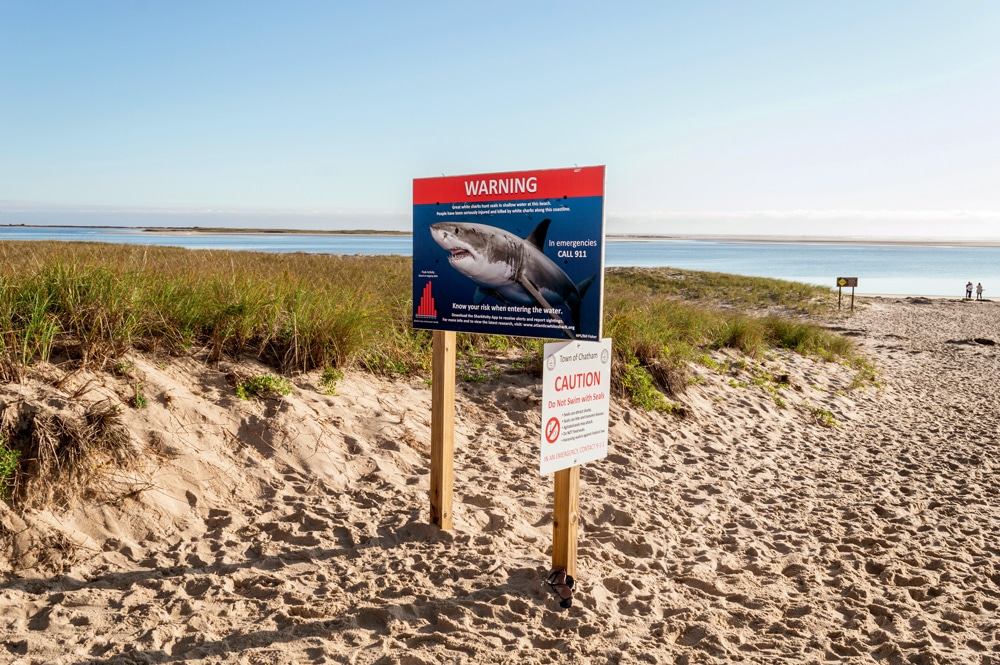
Photo Credit : Dan Logan/iStock
Sometimes public ire is directly focused on Skomal, who is derided by critics as a “shark hugger.” This highlights the difficult line he must walk as a level-headed scientist who has to make sure the debate around sharks and humans doesn’t go off the rails.
“If someone says, ‘Let’s kill all the seals,’ I say, ‘Let’s sit down and talk about it,’” Skomal said. “I want them to walk me through the mechanics of it. What would it mean to cull the seal population? Will you bring your kid on the boat with you when you shoot the seals? And once you’ve shot a seal, what do you with the body?
“And the bigger question is how many, because if you want to go back to how many we had in 1965, you’re going to have to kill 20,000,” he continued. “Now we get into the logistics of killing that many seals. ‘Well, we’ll just hire guys to kill them,’ they say. Well, those seals will pile up on the beach. And what will you do, use a machine gun on a [Cape Cod] National Seashore beach?
“This is the road I go down with people. At some point they either get frustrated and say that part is easy to sort out, or they say I’m crazy and walk away.”
I paid a visit to Skomal’s office in New Bedford in mid-November. A long spell of mild, dry weather had extended the tagging season deep into autumn, allowing him to work on the water a mere two days before we talked. This final stretch had been especially fruitful: 12 newly tagged sharks, including a record of five on one day in late October. In all, Skomal and his team had tagged 50 fish since June, a number he couldn’t have dreamed of in 2009, when his tally was just five.
“That’s a big-time record for us,” he said. “It’s unheard of.” He looked out the window at the ocean, whose choppy waters signaled the end of the season. “I’d keep going right until [the sharks migrate south], but I know that’s not going to happen.”
Like the generation of men he learned from—and it was mostly men back then—Skomal is more at home on a boat than at a desk. But the science he’s doing is much different from his predecessors’. Fifty years ago, Skomal’s old boss at the Narragansett lab, Jack Casey, relied on analog tags in his research. He’d catch a fish, attach a small capsule at the base of the dorsal fin, and insert a rolled-up piece of vinyl printed with the current size of the shark and where it had been caught. Later, if fishermen caught that same shark, and if they felt compelled to cooperate, they’d update the information and mail the sheet to Casey’s lab.
Today, the tech Skomal uses to study white sharks is beyond anything he could have imagined deploying even just two decades ago. There are video tags that show exactly what a shark sees, even at night, and satellite tags that can push live data about individual fish to mobile devices. Last summer Skomal experimented with a tracking device called an accelerometer that can document multiple body movements every second, indicating when a fish is resting, when it’s feeding, and when it’s hunting for prey—basically creating a detailed portrait of a shark in three-dimensional space. That kind of stuff excites Skomal not only because it speaks to his own wonky obsession but also because it may point the way toward how people and sharks can better coexist.
“I’m hoping we can produce information that will lead to predictability,” he said. “Ultimately our goal is to find patterns with these animals—then we can forecast where a white shark is likely to be hunting any given day or hour.”
Skomal doesn’t plan to retire anytime soon. He’s eager to see the results of the next phase of his research, and he’s invested in helping the next generation of biologists carry on the work he started.
During my visit in November, Skomal was preparing for a trip to St. Croix, where he planned to lead a graduate student and two faculty from the University of Massachusetts on a week of tiger shark tagging in the Caribbean. He would be hosting them at the condo his parents bought nearly half a century ago and working the same waters that inspired him when he was a kid.
“A lot of my love of this work started down there, and now we’re going back there to tag sharks,” he said, and smiled at the thought. “It’s come full circle.”
See More:The Shark Man | Q&A with Greg Skomal
Ian Aldrich
Ian Aldrich is the Senior Features Editor at Yankee magazine, where he has worked for more for nearly two decades. As the magazine’s staff feature writer, he writes stories that delve deep into issues facing communities throughout New England. In 2019 he received gold in the reporting category at the annual City-Regional Magazine conference for his story on New England’s opioid crisis. Ian’s work has been recognized by both the Best American Sports and Best American Travel Writing anthologies. He lives with his family in Dublin, New Hampshire.
More by Ian Aldrich

